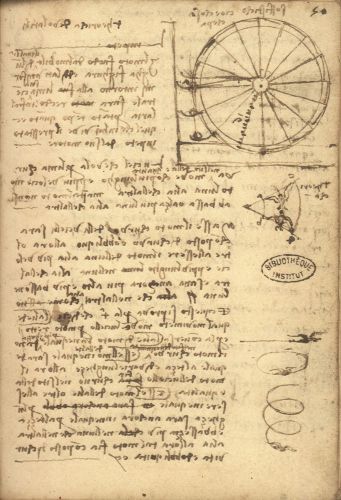Error
Perpetual hydraulic wheel
On a page entirely dedicated to the study of the flight of birds, Leonardo draws a box in which he illustrates an overbalanced wheel, without comment and description other than the observation “sophistic, that is what see” (according to Marinoni, the last word reads “seems”). It is a wheel with radial sectors that represent paths in which spheres are free to slide. The external rim can be opened in every sector with a spoon-shaped flap that allows the sphere, after the impact, to have an extra run that increases the lever arm, thus favouring rotation. The wheel turns with its lower end immersed in water, so as to exploit the greater density of the liquid and the hydrostatic thrust to close the flaps of the wheel and reposition the spheres in the internal paths. There is no reference to how the doors can remain closed once they have being lifted out of the water, when gravity would still tend to open them and cause the spheres to fall out, or to the wheel’s ability to lift water. It is probably an adaptation of a model devised by another engineer, drawn here so that he can bear it in mind. Moreover, the division of the radius into sixteen parts denotes the attempt to identify a proportional relationship between the number of paths, which are sixteen, and the length of the radii. Finally, it should be noted that this system with gravity tipping spoons had already been investigated in the manuscripts by the Sienese engineers, in particular Francesco di Giorgio, who used the mobile spoon as the blade of a water wheel.


